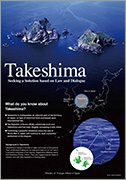Finally, Japanese Ministry of Foreign Affairs renewed HP and uploaded English version of Takeshima video.
Korean government instantly protested.
The Issue of Takeshima
゛Takeshima - Seeking a Solution based on Law and Dialogue”
MOFA of Japan also released a leaflet on Takeshima. You can download from below.

"Japan's position on Takeshima"
なぜかヤル気が感じられない外務省動画。
ReplyDelete外務省の動画へのコメントがありませんので、私の感想です。
日本語版に続き、英語版も公開されました。
日本語版は1分30秒ほどの、かなり早口な説明でした。
竹島に関して知識があまりない人にとって、動画は夢中で説明を続けているだけで、何だかよく分からなかったという意見もあるようです。またインターネット上では、語り手が早口な点に関して、難聴の方から字幕を付けて欲しかったという意見を目にしました。私も、テロップで全文を入れるべきだったと思います。ユーチューブには、字幕のオンオフ機能もあります。画面上が繁雑になるのを避けるには、そういった配慮をするべきで、それを全く配慮していないことは、高齢者や聾者の方をまったく無視しているわけです。この動画は、どこか腰が引けた外務省のやる気のなさを示しているように思えてなりません。
日本語版の動画を見る人を、日本人に限定して考えてはいけないと思います。外国人の日本語学習者もいるでしょうし、韓国人が、日本語動画で何を言っているのか、興味のある人も多いはずです。この点で、日本語字幕機能を利用していないのは甚だ不親切であると思います。
再生数は、55万回を越えていますが、絶対数を考えると、あまり多いようには思えません。テレビの内閣府のスポットCMで流すべきだと思います。
英語版は、日本語版より長い2分00秒です。日本語版より長いので、踏み込んだ説明があるのかと期待しましたが、内容は日本語版の翻訳であり、ほとんど同じ内容でした。
外国人にも聾唖者はいるわけで、こちらも字幕機能が利用されていないことが不満です。
時間は30秒ほど伸びたにも関わらず、文法的に単語数も増えたせいか、英語の説明は、私には日本語よりも、更に早口に聞こえました。英語版の再生回数は、現在11万5千回を越えていますが、視聴者は、今のところ日本人が多いのではないでしょうか。
日本人の英語学習者にとっては、「戦後」という部分で、afterを使わずにfollowingを使うなど、全体が堅い英文であるために、字幕は必要であったと思います。
特に中学生や高校生には、reaffirmedやjurisdiction といった単語は、聞き取りにくいと思います。これは字幕を付ければ、良い英語教材になったと思います。
Lies, Lies, Lies!
ReplyDeleteThis video is full of lies to mislead the non-Japanese viewers.
I always wonder if Japan is truly one of the leading countries of the world when it comes to its claim on Dokdo.
1.Takeshima became part of Japan in the 17C.
Japan has no evidence for it. In 1696, Tottori Han clearly answered to the inquiry of Edo Government Dokdo wasn’t belonging to any province of Japan. (松島は、何れかの国に附属する島ではないと聞いています。) The Maeji Government ordered the Japanese officials to investigate how Dokdo became Korean land in 1870 and said Japan had nothing to do with another island(Dokdo) in 1877. In spite of those evidence, the current Japanese government lies Japan established sovereignty over Dokdo at least in the late 17C based on the Japanese fishermen’s illegal fishing activities on Dokdo.
Edo Government’s Inquiry and Tottori Han’s Answer (1696): https://docs.google.com/document/d/14-nTEJ-1NXQQTlsP92tDugQUaKjhN7TjnAK-D2Icyoo/edit
How Matsushima(Dokdo then) became Koreanland(1870):
http://docs.google.com/document/d/11MJhsHx4yfxhf-b6tYEA3y_Ex-OfmE6Ma11wK2OrYhU/edit
Japan has nothing to do with another island(Dokdo)(1877): https://docs.google.com/document/d/1ooW-rQxIZb7IBpTILl4da6d4EeJFhDwisR3-xeR8llU/edit
2.Japan reaffirmed its intention to claim its sovereignty over Takeshima by a Cabinet Decision.
Japan’s incorporation of Dokdo was motivated by a Japanese business man who wanted Korean government to lease him the Korean Dokdo. His simple plan to ask to lend Korean Dokdo to him was changed into the request of incorporation of the island into Japanese land by the Japanese officials driven by greed for Dokdo. In 1904, Japanese Cabinet didn’t say Japan incorporates Takeshima(Dokdo) to reaffirm its sovereignty over Takeshima. It said there were no traces of occupation by any other countries, which means Japan had never occupied that island before and Japan could take it because it was ownerless. Korea had lots of traces of occupying that island. Japanese official from Ministry of Home Affairs said "The gains would be extremely small while the situation would become grave if the acquisition of a barren islet suspected of being Korean territory at this point of time [during the Russo-Japanese War] should amplify the suspicions of various foreign countries that Japan has an ambition to annex Korea." It's one of the traces of Korean occupying Dokdo.
The Way Japan Incorporated Dokdo(1905:
https://docs.google.com/document/d/1WFqfiuqkQGpDtZYyVjzngtkH68mPgZTtHMSNOUeCSGs/edit
(To be continued)
This comment has been removed by the author.
ReplyDelete3. When the San Francisco Peace Treaty was being negotiated following the World War 2, the Republic of Korea requested the United States to include Takeshima in the territories that Japan should renounce. The United States rejected the request on the grounds Takeshima was under the jurisdiction of Japan. Consequently, Takehsima was not included in the territories to be renounced. And therefore, internationally recognized Takeshima belonged to Japan.
ReplyDeleteI wonder how many Japanese believe this false claim. U.S. was not the only signatory for SF Treaty. The fact U.S. rejected to include Dokdo in the territories Japan should renounce based on the Japanese false information doesn’t mean the other 47 signatories agreed with U.S. position. John Foster Dulles who was deeply involved with in the draft of SF Treaty clearly said U.S. view on Dokdo was simply that of one of many signatories to treaty. (Link)
Rusk Note was nothing but an evidence showing U.S. secret support for Japanese claim over Dokdo. In other words, it was never been reflected in the final decision of SF Treaty signed by the Allied Powers. U.S. made it clear U.S. support for Japanese claim over Dokdo was just one of the views of the Allied Powers.
Then, what is the territory of Japan defined in SF Treaty? John Foster Dulles said as follows:
"What is the territory of Japanese sovereignty? Chapter II deals with that. Japan formally ratifies the territorial provisions of the Potsdam Surrender Terms, provisions which, so far as Japan is concerned, were actually carried into effect 6 years ago.
The Potsdam Surrender Terms constitute the only definition of peace terms to which, and by which, Japan and the Allied Powers as a whole are bound. There have been some private understandings between some Allied Governments; but by these Japan was not bound, nor were other Allies bound. Therefore, the treaty embodies article 8 of the Surrender Terms which provided that Japanese sovereignty should be limited to Honshu, Hokkaido, Kyushu, Shikoku and some minor islands. The renunciations contained in article 2 of chapter II strictly and scrupulously conform to that surrender term." <(Link)
There’s no any mention of Rusk Note in his explaining the Japanese territory decided by SF Treaty. Instead, John Foster Dulles said Japanese sovereignty should be limited to Honshu, Hokkaido, Kyushu, Shikoku and some minor islands as the Allied Powers determine. Definitely, Dokdo wasn’t included among some islands as the Allied Powers determined. What the Allied Powers determined was the separation of Dokdo from Japan. (Link)
Japanese sovereignty claim over Dokdo is based on the invalid U.S, Document which was never reflected in SF Treaty. Japanese government is misleading her own people to believe blindly the Rusk Note.
(To be contined)
韓国による日本語版の竹島動画が出ました。内容的には、レベルの低い大嘘の連続で呆れてしまいますが、起こしてみました。
ReplyDeletehttp://dokdo.mofa.go.kr/jp/pds/video_list.jsp
http://www.youtube.com/watch?v=7Ido7y1V0dA
『大韓民国の美しい領土 独島』
[カモメの鳴き声に続いて、タイプ音]
独島は日本による韓半島侵奪の最初の犠牲の地です。
大韓民国 第3代 外務部長官 卞栄泰 1954.10.28.
「東海に浮かぶ平和な大韓民国の島トクト、ここにも悲しい過去がありました。♪帝国主義の野心に燃えていた日本は、1904年、日露戦争を起こします。そして1905年、ロシア艦隊を監視するため、トクトを主人のない島だとして、不法に編入します。それも中央政府ではない地方政府の告示によって密かに。しかし、果たして日本の主張通り、トクトは主人のない島であったのでしょうか?」
歴史は知っている
「1145年に完成した三国史記を含め、韓国の数多くの古文献と地図は、ドクトについて古来から韓国の領土であると記録しています。特に1454年に編纂された、セジョン(世宗)実録地理志は、ウルルンド(鬱陵島)とドクト(独島)の位置を正確に明記しています。
そして、1900年、大韓帝国は勅令第41号をもって、トクトが韓国の領土であることをあらためて明確にします。」
日本も知っている
「日本の記録はどうでしょうか? 日本は、1905年まで、ただの一度も、トクトが日本領であると主張したことがありません。むしろ数多くの日本の文献は、トクトが日本の領土ではないとはっきりと示しています。17世紀末、日本は「竹島一件」を通じて、ドクトが日本領ではないということを自ら認めています。」♪
「さらに1877年、当時の最高行政機関である太政官は、日本全域の地籍を編纂する過程で、綿密な調査の末、トクトが日本とは関係ないという結論を出します。110年間隠されていて、1987年にやっと世の中に姿を現したこの太政官指令は、ドクトが日本の領土ではないと言うことを、日本政府が公式に確認した明白な証拠です。」
「ところが日本はそれまでの主張を変え、元々日本固有の領土であったと無理な主張を始めます。以前は主人のない島だと言っていたのに、今はもともと自国の領土であったと、まるで手の平を返すように変わる日本の主張を一体誰が信じるでしょうか?」
「トクトは日本による韓半島侵奪の最初の犠牲の地です。1945年、第二次世界大戦が終わり、カイロ、ポツダム宣言など戦後処理の過程で、敗戦国の日本は、暴力と貪欲によって奪い取った全ての地域から放逐されます。」
「ドクトも韓国の元へ戻って来ました。そして1946年、連合国最高司令官覚え書き第677号は、ドクトが韓国の明白な行政管轄区域であると宣布します。トクトは大韓民国の主権回復の象徴です。日本以外のどの国も、ドクトが奪われてから再び取り戻された韓国の領土であることを否定しません。ドクトが自国領であると言い張る日本の主張は、韓半島侵奪の歴史を繰り返すと言っているのと同然です。我々は共に未来を切り開いて行くべき日本が、歴史の真実の前で、謙虚になることを望みます。♪」
「これからもドクトは大韓民国東海の平和な島としてありつづけるでしょう。♪」
小嶋さん
ReplyDeleteコメント起こし、ありがとうございます。
すべて論破されていることばかりなのが、よくわかります。
日本政府の領土問題のホームページでは、
担当大臣の一般論的な発言ばかりでなく、
これらのひとつひとつの歴史的事実について、
具体的に反論して、日本語だけでなく、韓国語・英語で発信すべきです。
予算はついたんですよね。
政府としては将来の国際司法裁判所での対決ということも考慮しておく必要があるので、今の段階で具体の主張に逐一反論するのは得策ではないという事情があるかも知れません。「竹島は日本の固有の領土であり、それを韓国が不法占拠しているが、日本は平和的解決を追求する」というくらいを述べておくのが適当だという判断があったとしても不思議ではないと思います。
ReplyDeleteその点、島根県は裁判の当事者にはならないので、比較的自由な立場で、例えば100問100答などの形で具体の主張に反論することが可能だし、現時点ではそれが効果的な方法でしょう。
This comment has been removed by the author.
ReplyDeleteThis comment has been removed by the author.
ReplyDeletehttp://www.dokdoandeastasia.com/ja/main.php
ReplyDeleteFalse claims against the Japanese government and the people are. Dokdo is Korea's own territory.
日本政府は国民に対し、虚偽の主張をしています。独島は韓国の固有の領土です。
독도
ReplyDeletehttp://www.dokdoandeastasia.com/
False claims against the Japanese government and the people are. Dokdo is Korea's own territory.
Japan is a land of their own, without accurate evidence because it insists.
Old map of Japan recently stated that the land in South Korea and the things you find.
日本政府は国民に対し、虚偽の主張をしています。独島は韓国の固有の領土です。
また、日本は、正確な証拠もなく、自分の土地だと言い張っています。
最近、日本の昔の地図でも韓国の地を明示するもの発見されています。
http://www.youtube.com/watch?v=mEF9FDh4nZc
ReplyDeletehttp://www.youtube.com/watch?v=7Ido7y1V0dA